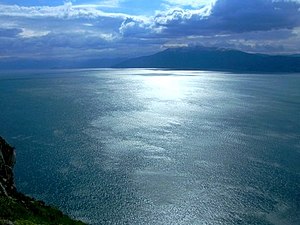
Argos is a city and former municipality in Argolis, Peloponnese, Greece and is one of the oldest continuously inhabited cities in the world, and one of the oldest in Europe. It is the largest city in Argolis and a major center in the same prefecture, having nearly twice the population of the prefectural capital, Nafplio.

Monemvasia is a town and municipality in Laconia, Greece. The town is located in mainland Greece on a tied island off the east coast of the Peloponnese, surrounded by the Myrtoan Sea. Monemvasia is connected to the rest of the mainland by a tombolo 400 metres (1,300 ft) in length.

The Argolic Gulf, also known as the Gulf of Argolis, is a gulf of the Aegean Sea off the east coast of the Peloponnese, Greece. It is about 50 km long and 30 km wide. Its main port is Nafplio, at its northwestern end. At the entrance to the gulf is the island Spetses. This gulf and its islands are sometimes combined with the Saronic Gulf and Saronic Islands, with the result called the Argo-Saronic Gulf and the Argo-Saronic Islands. It is surrounded by two regional units: Arcadia to the southwest and Argolis to the north and east. The river Inachos drains into the Argolic Gulf near Nea Kios. The main islands in the gulf are Psili, Plateia and Bourtzi, a small island with a Venetian fortress that protects the port of Nafplio. The surrounding mountains protect it from the strong summer Meltemi wind.

Nafplio or Nauplio is a coastal city located in the Peloponnese in Greece. It is the capital of the regional unit of Argolis and an important tourist destination. Founded in antiquity, the city became an important seaport in the Middle Ages during the Frankokratia as part of the lordship of Argos and Nauplia, held initially by the de la Roche following the Fourth Crusade before coming under the Republic of Venice and, lastly, the Ottoman Empire. The city was the second capital of the First Hellenic Republic and of the Kingdom of Greece, from 1827 until 1834.

The Great Turkish War or The Last Crusade, also called in Ottoman sources The Disaster Years, was a series of conflicts between the Ottoman Empire and the Holy League consisting of the Holy Roman Empire, Poland-Lithuania, Venice, Russia, and the Kingdom of Hungary. Intensive fighting began in 1683 and ended with the signing of the Treaty of Karlowitz in 1699. The war was a resounding defeat for the Ottoman Empire, which for the first time lost substantial territory, in Hungary and the Polish–Lithuanian Commonwealth, as well as in part of the western Balkans. The war was significant also for being the first instance of Russia joining an alliance with Western Europe. Historians have labeled the war as the Fourteenth Crusade launched against the Turks by the papacy.

Myloi, is a village in the southwestern part of Argolis, Greece. Myloi was the seat of the former municipality of Lerna. It is 4 km southwest of Nea Kios, 9 km south of Argos and 8 km west of Nafplio. The Greek National Road 7 passes through the village. It had a train station on the Corinth–Kalamata railway, but passenger service on this line was halted in 2010.

The water castle of Bourtzi is a Venetian castle located in the middle of the harbour of Nafplio.
Tolo, in Katharevousa known as Tolon (Τολόν), is a village in Greece on the Peloponnese peninsula. It is part of the municipal unit Asini, in Argolis.
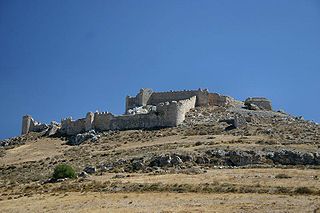
Larisa is the ancient and medieval acropolis of Argos, located on a high rocky hill, within the town's boundaries to the west. According to Strabo, it is named for a group of Pelasgians. The summit is occupied by the ruins of a Byzantine-Venetian castle, below it, roughly midway down the slope of the mountain, is Panagia Katakekrymeni-Portokalousa monastery, and opposite the castle entrance, the Monastery of Agia Marina, a nunnery. The site was fortified and in continuous use for nineteen centuries.
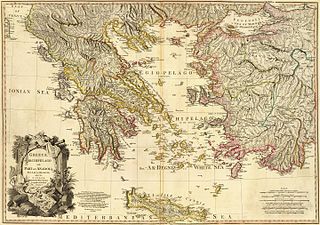
The Frankish Occupation, also known as the Latin Occupation and, for the Venetian domains, Venetian Occupation, was the period in Greek history after the Fourth Crusade (1204), when a number of primarily French and Italian states were established by the Partitio terrarum imperii Romaniae on the territory of the dismantled Byzantine Empire.

The Kingdom of the Morea or Realm of the Morea was the official name the Republic of Venice gave to the Peloponnese peninsula in Southern Greece when it was conquered from the Ottoman Empire during the Morean War in 1684–99. The Venetians tried, with considerable success, to repopulate the country and reinvigorate its agriculture and economy, but were unable to gain the allegiance of the bulk of the population, nor to secure their new possession militarily. As a result, it was lost again to the Ottomans in a brief campaign from June to September in 1715.

The Battle of Nauplia or Battle of Spetses was a series of naval engagements lasting from 8 to 13 September (O.S.) 1822 in the Gulf of Nauplia between the Greek Fleet and the Ottoman Navy during the Greek War of Independence. Although neither side sustained significant losses, the Ottomans withdrew after three failed attempts to break through the Greek fleet, and the battle is considered a Greek victory. The Ottoman fleet of eighty-four vessels under the command of Kara Mehmet Pasha was sent to destroy Greek forces at Hydra and Spetses and to relieve the besieged Ottoman garrison at Nauplia (Nafplio).
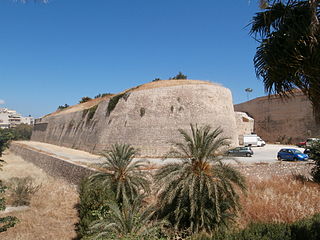
The fortifications of Heraklion are a series of defensive walls and other fortifications which surround the city of Heraklion in Crete, Greece. The first city walls were built in the Middle Ages, but they were completely rebuilt by the Republic of Venice. The fortifications managed to withstand the second longest siege in history for 21 years, before the city fell to the Ottomans in 1669.

The fortress of New Navarino is an Ottoman fortification near Pylos, Greece. It is one of two castles guarding the strategic Bay of Pylos, on which it sits; New Navarino is located in the southern entrance of the bay, while the northern entrance is guarded by the 13th-century Old Navarino castle, built by the Crusaders of the Principality of Achaea. In juxtaposition with the latter, New Navarino is often known simply as Neokastro or Niokastro.

The siege of Santa Maura took place on 21 July – 6 August 1684 between the forces of the Republic of Venice and the Ottoman Empire, and was the opening battle of the Sixth Ottoman–Venetian War. From his base at Corfu the Venetian commander-in-chief, Francesco Morosini, led a fleet of 38 galleys, 8 galleasses and several auxiliary vessels to besiege the Fortress of Santa Maura on the island of Lefkada, that was under Ottoman rule. The besieging forces were swelled by Greek levies and volunteers from the Ionian Islands. The siege lasted until 6 August, when the commander Bekir Agha, bowing to pressure from the 500 Albanians and 200 Greeks in the fortress garrison, surrendered to the Venetians.
The Ottoman reconquest of the Morea took place in June–September 1715, during the Seventh Ottoman–Venetian War. The Ottoman army, under Grand Vizier Silahdar Damat Ali Pasha, aided by the fleet under Kapudan Pasha Canım Hoca Mehmed Pasha, conquered the Morea peninsula in southern Greece, which had been captured by the Republic of Venice in the 1680s, during the Sixth Ottoman–Venetian War. The Ottoman reconquest inaugurated the second period of Ottoman rule in the Morea, which ended with the outbreak of the Greek War of Independence in 1821.
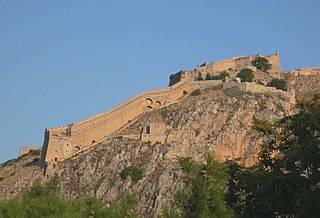
The siege of Nauplia took place on 12–20 July 1715, when the Ottoman Empire captured the city of Nauplia, the capital of the Republic of Venice's "Kingdom of the Morea" in southern Greece. Although Nauplia was strongly fortified and had been further strengthened with the construction of Palamidi fortress by the Venetians, the Ottomans managed to overcome them, largely through the treasonous assistance of the French colonel La Salle. The Ottomans exploded a mine and took Palamidi by storm on 20 July. The Venetian defenders retreated in panic, leading to the rapid fall of Acronauplia and the rest of the city. The garrison and populace were massacred or carried off as prisoners. The fall of Nauplia signalled the effective end of Venetian resistance to the Ottoman reconquest of the Morea, which was completed by 7 September.

The Castle of Santa Maura is a fortress on the northeastern tip of the Greek island of Lefkada. The castle began as a small fortification in c. 1300 to control access to the island, before it was expanded to become a walled town and the island's capital by the early 15th century. The Ottoman Empire took possession in 1479, and a century later rebuilt and enlarged it, giving it largely its present shape. A sizeable town grew outside the castle walls by the 1670s.

The Agha Pasha Mosque, also commonly known as the Parliament House, is a historical Ottoman mosque in the town of Nafplio, Peloponnese, in southern Greece. It was built in 1730, during the second period of Ottoman rule in the town, and it briefly functioned as the first parliament building of the Provisional Administration of Greece, hence its common name. Today, no longer open to worship, it houses cultural events.
Antonio Giancix was a Dalmatian (Croatian) officer, engineer and military architect in Venetian service.





